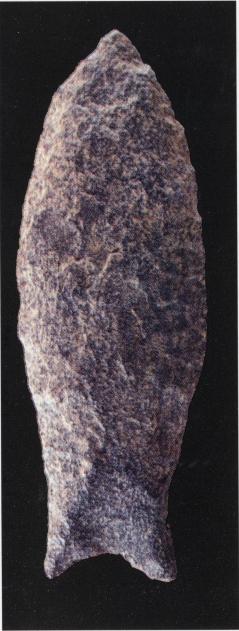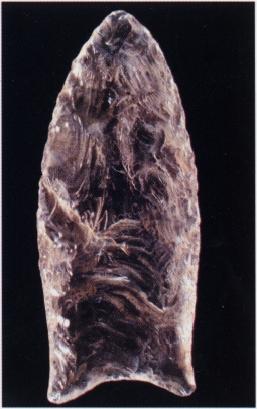by Ron L. Harris, Hickory, North Carolina
Originally Published in the Central States Archaeological Journal, Vol.56, No.4, pg.200Originally Published in the Central States Archaeological Journal, Vol.57, No.1, pg.39

Above: The author’s entire North Carolina Paleo collection assembled over a 55-year span. The North Carolina counties include: Randolph, Iredell, Rowan, Stanly, Montgomery, Moore, Johnston, Ashe, Alleghany, Alexander, Guilford, Wilkes, Surry, Buncombe, Madison, Clay, and Chatham.
The earliest prehistoric human occupation in North Carolina dates to the Paleo-Indian period, which is thought to have begun around 10,000 BC. The temporal marker for that period is the fluted projectile point usually recovered as a surface find on exposed surfaces such as plowed fields, road cuts, construction sites and eroding streams or fields.
Archaeologists recognize two main cultures within the Paleo-Indian period in the North Carolina Piedmont region. They are Clovis & Hardaway-Dalton.
The Clovis Culture made beautiful distinctive fluted spear points (9500 — 8500 BC) that show remarkable similarities across the American continent. The purpose of the Clovis flute or channel most likely was to facilitate the hafting process. The edges on both sides near the base were dulled, so as to prevent them from cutting through the bindings that attached the point to the spear shaft. It should be noted that as of yet no Clovis points have been excavated from an undisturbed stratified site or found in context with datable material in N.C.
The Hardaway-Dalton Culture made differently styled spear points with shallow indentations on each side of the blade near the basally thinned base with ground (dulled) proximal blade edges (8500 — 8000 BC).
Another projectile point type that figures into the Paleo-Indian time frame in the N.C. Piedmont is the Alamance point. It is believed to be a variant or sub-type of the Hardaway-Dalton with both occurring in the same time frame.
Infrequently, Simpson type points of the late Paleo period are found in the lower N.C. Piedmont regions. However, this type is usually found in the Deep South such as Florida and South Georgia. Fluting for the Simpson point is absent or weak but basal areas are ground. The hafting area is constricted or “waisted”.
Spears tipped with these unique types of stone points were the main hunting tools in the Paleo-Indian time frame.
These First Carolinians were nomadic hunters & gatherers who moved regularly through vast territories on a seasonal basis in search of new resources. They lived in small family groups that archaeologists call bands. Subsistence comes from the hunting and gathering of wild foods. They carried or pulled all of their possessions from one location to another and therefore built no permanent dwellings. Protection from severe weather consisted of temporary shelters constructed from sticks and brush, forest thickets or the occasional rock shelter. Clothing and mats were likely from plant fibers and animal hides. Containers may have included bark and/or animal bags, gourds and woven nets from vines or grass. The most important excavated N.C. site yielding Paleo-Indian components is the Hardaway Site (31-ST-4) on the west bank of the Yadkin River near the town of Badin in Stanly County, N.C. The Hardaway site investigations formed the basis of Paleo-Indian and Early Archaic sequences for the Carolina Piedmont as defined by Joffre L. Coe (1964).


Simpson type Paleo point found in Chatham County, North Carolina in the Cape Fear River drainage. Short flutes or basal thinning on both sides. Rare ttype for N.C. in that this type is usually found in the deep-south region. However, this point is made from Rhyolite material indigenous to central N.C. where the point was recovered. Size: 3 1/2 inches. Collection of the author.
The classic fluted Clovis point was not recovered from Hardaway; however, it is thought by archaeologists to be contemporary with the Hardaway phase, which represents the earliest occupation at the site and dates to at least 8000 BC (Ward 1983).
The Hardaway Corner-Notch projectile point evolved from the Hardaway-Dalton. It is smaller with “U” shaped corner-notches. Archaeologists consider this particular type to be the beginning of the Early Archaic period in N.C. dating to about 8000 BC.
Some archaeologists think the earliest Paleo-Indians lived mostly in the Piedmont because more fluted points have turned up there than elsewhere in the state. The Piedmont was probably a more climate hospitable region to live in as opposed to the colder mountains.
Paleo-Indian sites on the low-lying Coastal Plain may presently be invisible, having been inundated by rising sea levels or deeply buried in floodplain soils. Widely scattered Paleo-Indian artifacts of the Clovis-Hardaway-Dalton types have been found in the mountains and foothills of North Carolina but presently no significant undisturbed locations for this period exist there either. This may be due in part to these First Carolinians favoring hilltops or ridges for their camps. This allowed centuries of rain and weather to erode and wash away their sites.
Most of the Paleo-Indian type spear points seem to be produced from local lithic material leading archaeologists to conclude these ancient points were manufactured by resident Native Americans and not simply lost by seasonal hunting parties from outside (Purrington 1983). In the N.C. Piedmont this preferred raw material consisted of high-quality metavolcanic rocks found in the Slate Belt. Most stone tools found in the Piedmont that date to the Paleo-Indian period, as well as later periods, were made from this fine-grained, metamorphosed volcanic rock called rhyolite. Rhyolite outcrops are restricted to the area of the Slate Belt in and around the Uwharrie Mountains of Stanly & Montgomery Counties in south-central N.C.


Above: This late-Paleo Hardaway-Dalton point is made of porphyritic Rhyolite. It was recovered in the Cedar Square community near Randleman in northern Randolph County, North Carolina. Size: 3 inches. Collection of the author.


Above: Very rare clear quartz crystal fluted point found by Blake Deal in the Brushy Mountain community of “Vashti” of northern Alexander County, North Carolina. Size: 2 inches. Collection of the author.
It is not by accident that the site of the most important Paleo-Indian and Early Archaic search in N.C. — The Hardaway Site — also is located in the Uwharrie Mountains.
Rodney Peck, president of the Piedmont Archaeology Society of Virginia and the Carolinas, has undertaken the monumental task of recording fluted points found in North Carolina. This has been an ongoing task for many years and hundreds of fluted points have officially been recorded and are still being recorded in his survey.
Accompanying this article are several photographs illustrating examples of various Paleo-Indian projectile point types (Clovis, Hardaway-Dalton, Alamance & Simpson) typically recovered in the Piedmont and Blue Ridge foothills regions of North Carolina.
“Used by Permission of the Author”
To learn more about or to join the Central States Archaeological Society, click here:CSASI.org
